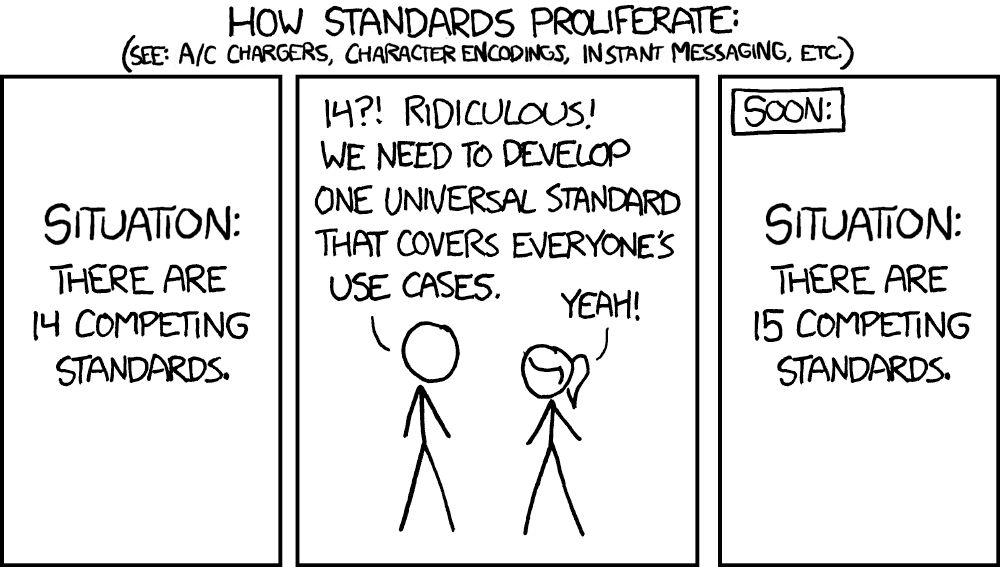...Despite North ‘Mericans endlessly raving about how they love the Tesla Proprietary Connector, it really isn’t a good design. Apart from not supporting 3-phase, using the same pins for AC and DC depending on context not only adds complication and expense on both the vehicle and charger side, it creates a risk of the mother-of-all-failure modes.
- I am not an electrical expert or an engineer.
- Though a native citizen, I feel free to criticize the United States where criticism is warranted. To demonstrate, I openly acknowledge an unfortunate (albeit arguably understandable) post WWII tendency in the US towards social, political, economic, and technological imperialism and imagined superiority. (We are only now as a country being dragged kicking and screaming towards just partly coming to grips with the damage and hypocrisy of our erroneous prior thinking and actions--not only from the 1950s and '60s, but ultimately from a horrendous pre-US Civil War social experiment in cruelty, immorality, and economic avarice that more than any other one thing severely damaged this country. I might add that Australia has its own 'skeletons in the closet.')
- But back to the topic at hand, I fully accept that historic electrical grid design, traditional electrical engineering, and political realities in Europe, Oceania, and Asia can and should dictate electric car charging procedures there. Since the North American Tesla Proprietary Charge Standard apparently won't work well in other counties (e.g., because of the Phase 3 issue), then North America cannot, should not, and as far as I know is not attempting to force its standard on other areas.
- That said, I think the (apparent) move to a North American regional standard (NACS) based on the NA Tesla charging plug and port is a good thing, for us...here...where Phase 3 electricity is apparently not readily available to average drivers.
- I'll let other, more knowledgeable readers comment, but I question whether the Tesla plug/port are really the risk you make them out to be. We all have seen reports of apparent problems with NEPA 14-50 wall receptacles in North America. We all have read about the (imagined) dangers of, for example, 'suicide' charging adapter use (in New Zealand and Australia). The point is that TMC members seem to be good about reporting electrical issues. The Tesla charging standard has been used--safely, as far as I know--in North America since 2012. Where are the reliable reports about widespread Tesla plug/port failures? Of course it is difficult or impossible to prove a negative, but the lack of such reports seems to suggest that the convenient Tesla plugs/ports in use here are a triumph of Tesla engineering.
I much prefer CCS2 and the very satisfying clunk when you plug it in. Its solidity gives me comfort. And the Type 2 plug by itself for AC charging is almost the same size as the TPC - just as sleek.
And electric car drivers are welcome to keep using the CCS2 standard. But the result is that--for various reasons--drivers in Oceania and Europe no longer have a lightweight, convenient, well-built plug/port for
both AC and DC.* We
do. Considering what Tesla went through in its early years before release of the Model S (e.g., being ostracized by other electric car manufacturers) to develop its elegant North American plug/port standard, I think Tesla as a company should be applauded (while being rightly criticized for plenty of wrong steps).
The USA, in the meantime, has gone the other way - from having 2 ”standards” (CCS1 and CHAdeMO) to 3 “standards” (CCS1, CHAdeMO and the Tesla Proprietary Connector)

. Reminds me of an xkcd cartoon…
I'm sorry, but that is not really true.
Tesla started offering CHAdeMO adapters to North American customers in 2015, probably because the Supercharger network was still nascent and there were not a lot of (or any?) other options for DC on-the-road charging at that time. Although most (US) drivers do not really need to fast charge on a daily basis, some do. And drivers apparently
do need assurance that opportunities are available if and when needed. The Japanese had a DC charger standard. Nissan had been using it since 2010. Tesla saw an opportunity and, in my opinion, is to be congratulated for at least offering its NA drivers with another (albeit 'clunky') option (for places where Superchargers hadn't been built yet).
As others are pointing out, across the entire Tesla driver base CHAdeMO was probably never super popular (it was always ungainly and expensive), and now is definitely fading as a standard in North America. As we all know, Tesla stopped offering CHAdeMO adapters in 2021 (and a year later offered its CCS1 adapter as a better replacement). Yes, CHAdeMO adapters and charging equipment are still available and apparently still useful to some Tesla drivers, especially in more out-of-the-way areas and for cars not yet able to use CCS equipment. But even that use will eventually diminish. We all now see how once an idea catches on, today's technology changes rapidly. In point of fact, North America has two real on-the-road DC charging standards now (CCS and Tesla), and by the look of things will have just one within the next 10 to 20 years, if not sooner.
_____
* As you point out, for Models S & X that used to be the Type 2/Mennekes plug and corresponding port, which (like the NA plug) conveniently handled both AC and DC charging. Too bad that other manufacturers couldn't or wouldn't adopt that standard for their electric cars in those regions.
All V3 superchargers in Australia, and probably a few other countries, are exclusively this format. Either 3 or 6 stall sites.








